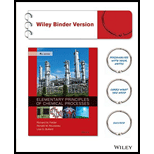
Concept explainers
The standard heat of the reaction
is
- Briefly explain what that means. Your explanation may take the form "When
(specifyquantities of reactant species and their physical states) react to form
(quantities of product
species and their physical state), the change in enthalpy is
What is
- for
- Estimate the enthalpy change associated with the consumption of 340 g NH3/s if the reactants and products are all at 25°C. (See Example 9.1-1.) What have you assumed about the reactor pressure? (You don't have to assume that it equals 1 atm.) The values of
(a)
To explain:
The given equation
Concept introduction:
When chemical reaction transforms the matter, there will be change in enthalpy in a system. This will happen when the products and reactants which involves in the chemical reaction are in their states. This is called standard heat or enthalpy of reaction.
Answer to Problem 9.1P
When 4 moles of gaseous ammonia and 5 moles of gaseous oxygen react to form 4 moles of gaseous nitric oxide and 6 moles of gaseous water, the change in enthalpy is
Explanation of Solution
The standard heat of the reaction is,
When 4 moles of gaseous ammonia and 5 moles of gaseous oxygen react to form 4 moles of gaseous nitric oxide and 6 moles of gaseous water, the change in enthalpy is
(b)
To say:
Whether the reaction is exothermic or endothermic. To maintain the temperature constant, what would we do? If we ran the reactor adiabatically, what will be the state of the temperature?
Concept introduction:
A system will either absorbs heat or release heat to the surroundings. Exothermic reaction is the one where the heat gets released and endothermic reaction is the one where the heat gets absorbed. In exothermic, value of
Answer to Problem 9.1P
The reactor should be kept cool, to keep the temperature constant. The given reaction is exothermic. If the reactor is ran adiabatically, the temperature will get raise. The energy needed is low to break the reactant’s molecular bonds.
Explanation of Solution
We have
(c)
To find:
The
Concept introduction:
When chemical reaction transforms the matter, there will be change in enthalpy in a system. This will happen when the products and reactants which involves in the chemical reaction are in their states. This is called standard heat or enthalpy of reaction.
Answer to Problem 9.1P
Thus, the
Explanation of Solution
When we compare the reaction
So, for the reaction
Therefore, for the reaction
(d)
To find:
The
Concept introduction:
When chemical reaction transforms the matter, there will be change in enthalpy in a system. This will happen when the products and reactants which involves in the chemical reaction are in their states. This is called standard heat or enthalpy of reaction.
Answer to Problem 9.1P
Thus, the
Explanation of Solution
When we compare the reaction
So, for the reaction
Therefore, for the reaction
The reactants and products of the two reactions get reversed. So, the sign will also change.
(e)
To estimate:
The enthalpy change and the reactor pressure.
Concept introduction:
When chemical reaction transforms the matter, there will be change in enthalpy in a system. This will happen when the products and reactants which involves in the chemical reaction are in their states. This is called standard heat or enthalpy of reaction.
Answer to Problem 9.1P
Thus, the change in enthalpy at
Explanation of Solution
For the reaction
For 4g of
Converting 1g of
Converting 340g of
The change n enthalpy is,
The reactor pressure is same for reactants and products.
(f)
To explain:
Whether water exists as a vapor at
Concept introduction:
When chemical reaction transforms the matter, there will be change in enthalpy in a system. This will happen when the products and reactants which involves in the chemical reaction are in their states. This is called standard heat or enthalpy of reaction.
Answer to Problem 9.1P
Thus, the water exists as a vapor at
Explanation of Solution
Pure water will vapor at lower temperature. Therefore, water exists as a vapor at
Want to see more full solutions like this?
Chapter 9 Solutions
Elementary Principles of Chemical Processes, Binder Ready Version
Additional Engineering Textbook Solutions
Elements of Chemical Reaction Engineering (5th Edition) (Prentice Hall International Series in the Physical and Chemical Engineering Sciences)
Process Dynamics and Control, 4e
Fundamentals of Heat and Mass Transfer
Starting Out with Programming Logic and Design (4th Edition)
Starting Out with C++: Early Objects (9th Edition)
Starting Out With Visual Basic (8th Edition)
 Introduction to Chemical Engineering Thermodynami...Chemical EngineeringISBN:9781259696527Author:J.M. Smith Termodinamica en ingenieria quimica, Hendrick C Van Ness, Michael Abbott, Mark SwihartPublisher:McGraw-Hill Education
Introduction to Chemical Engineering Thermodynami...Chemical EngineeringISBN:9781259696527Author:J.M. Smith Termodinamica en ingenieria quimica, Hendrick C Van Ness, Michael Abbott, Mark SwihartPublisher:McGraw-Hill Education Elementary Principles of Chemical Processes, Bind...Chemical EngineeringISBN:9781118431221Author:Richard M. Felder, Ronald W. Rousseau, Lisa G. BullardPublisher:WILEY
Elementary Principles of Chemical Processes, Bind...Chemical EngineeringISBN:9781118431221Author:Richard M. Felder, Ronald W. Rousseau, Lisa G. BullardPublisher:WILEY Elements of Chemical Reaction Engineering (5th Ed...Chemical EngineeringISBN:9780133887518Author:H. Scott FoglerPublisher:Prentice Hall
Elements of Chemical Reaction Engineering (5th Ed...Chemical EngineeringISBN:9780133887518Author:H. Scott FoglerPublisher:Prentice Hall
 Industrial Plastics: Theory and ApplicationsChemical EngineeringISBN:9781285061238Author:Lokensgard, ErikPublisher:Delmar Cengage Learning
Industrial Plastics: Theory and ApplicationsChemical EngineeringISBN:9781285061238Author:Lokensgard, ErikPublisher:Delmar Cengage Learning Unit Operations of Chemical EngineeringChemical EngineeringISBN:9780072848236Author:Warren McCabe, Julian C. Smith, Peter HarriottPublisher:McGraw-Hill Companies, The
Unit Operations of Chemical EngineeringChemical EngineeringISBN:9780072848236Author:Warren McCabe, Julian C. Smith, Peter HarriottPublisher:McGraw-Hill Companies, The





